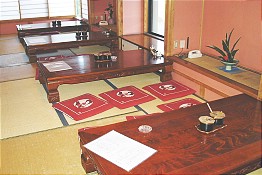Tables and sitting
In Japan, some restaurants and private houses are equipped with low Japanese style tables and cushions on the floor, rather than with Western style chairs and tables. Please visit our information page about sitting techniques and rules for more information.
 A restaurant with traditional low tables
A restaurant with traditional low tables
Itadakimasu and Gochisosama
In Japan, you say "itadakimasu" ("I gratefully receive") before starting to eat, and "gochisosama (deshita)" ("Thank you for the meal") after finishing the meal.
Individual versus shared dishes
It is not uncommon in private households and in certain restaurants (e.g. izakaya) to share several dishes of food at the table rather than serving each person with his/her individual dish. In such a case, you are supposed to move some food from the shared plates onto your own plate by yourself, using the opposite end of your chopsticks (if you have used them already) or with special chopsticks that may be provided for that purpose.
Chopsticks
The proper usage of chopsticks is the most fundamental element of Japanese table manners, and therefore, we have assigned them a separate information page.
Some Table Rules
- Blowing your nose in public, and especially at the table, is considered bad manner.
- It is considered good manner to empty your dishes to the last grain of rice.
- Talking about toilet related and similarly disappetizing topics during or before a meal is not appreciated by most people.
- Unlike in some other parts of East Asia, it is considered bad manner to burp.
- After finishing eating, try to place all your dishes in the same way as they were at the start of the meal. This includes replacing the lid of dishes which came with a lid and replacing your chopsticks on the chopstick holder or into their paper slip, if applicable.
- Read more about chopstick rules.
Drinking rules
When drinking alcoholic beverages, it is a Japanese custom to serve each other, rather than pouring the beverage into one's own glass. You are supposed to periodically check your friends' cups, and serve them more once their cups are getting empty. Likewise, if someone wants to serve you more alcohol, you should quickly empty your glass and hold it towards that person.
While it is considered bad manner to become obviously drunk in some formal restaurants, for example in restaurants that serve kaiseki ryori (Japanese haute cuisine), the same is not true for other types of restaurants such as izakaya, as long as you do not bother other guests.
Do not start drinking until everybody at the table is served and the glasses are raised for a drinking salute, which usually is "kampai". Avoid using "chin chin" when drinking a toast, since in Japanese this expression refers to the male genitals.
How to eat...
 |
... Rice:
Take the rice bowl into one hand and the chopsticks into the other and lift it towards your mouth while eating. Do not pour soya sauce over white, cooked rice. |
 |
... Sushi:
Pour some soya sauce into a the small plate provided. It is considered bad manner to waste soya sauce, so try not to pour more sauce into your plate than you are actually going to be using.
You do not need to add wasabi into your soya sauce, because the sushi pieces usually already contain wasabi, and some sushi pieces are supposed to be eaten without wasabi. If you choose to add wasabi, nonetheless, use only a small amount, in order not to offend the sushi chef. If you do not like wasabi, you can request that none is added into your sushi.
In general, you are supposed to eat a sushi piece in one bite. Attempts to separate a piece into two, most often end in the destruction of the beautifully prepared sushi. Hands or chopsticks can be used to eat sushi.
In case of nigiri-zushi, dip the piece into the soya sauce upside-down with the fish part ahead. A few kinds of nigiri-zushi, for example, marinated pieces, should not be dipped into soya sauce.
In case of gunkan-zushi, pour a small amount of soya sauce over it, rather than dipping it into the sauce. |
 |
... Sashimi:
Give some soya sauce into a small plate provided. Put some wasabi on the sashimi piece, but do not use too much wasabi as this would overpower the taste of the raw fish and possibly offend the chef. Use the sauce for dipping the sashimi pieces. Some types of sashimi are enjoyed with ground ginger rather than wasabi. |
 |
... Miso Soup:
Drink the soup out of the bowl as if it were a cup, and fish out the solid food pieces with your chopsticks. |
 |
... Noodles:
Lead the noodles with your chopsticks step by step into your mouth, while sucking them in with a controlled slurping sound. Try to copy the slurping sound of people around you.
In case of noodle soups, keep the distance between the bowl and your mouth small in order to avoid splashing. If a ceramic spoon is provided, use it to drink the soup, otherwise, lift the bowl to your mouth in order to drink the soup. |
 |
... Kare Raisu:
(and other dishes in which the rice is mixed with a sauce)
Kare Raisu (Japanese style curry rice) and other rice dishes, in which the rice is mixed with a sauce (for example, some domburi dishes) and may become a little bit difficult to eat with chopsticks, are often eaten with large spoons rather than chopsticks. |
 |
... Big pieces of food:
(e.g. prawn tempura, tofu)
Separate the piece with your chopsticks (this takes some exercise), or just bite off a piece and put the rest back onto your plate. |
|
